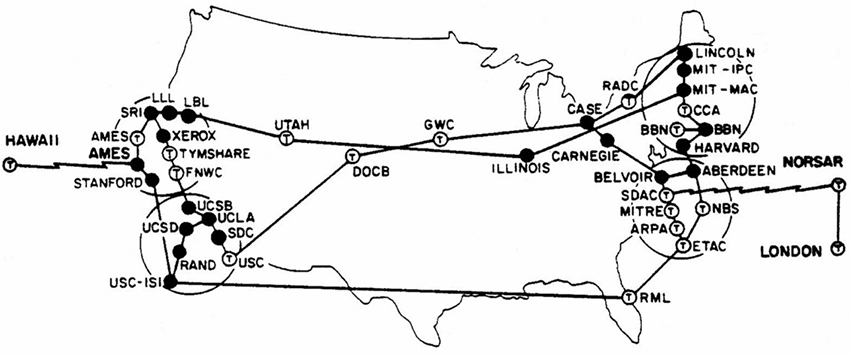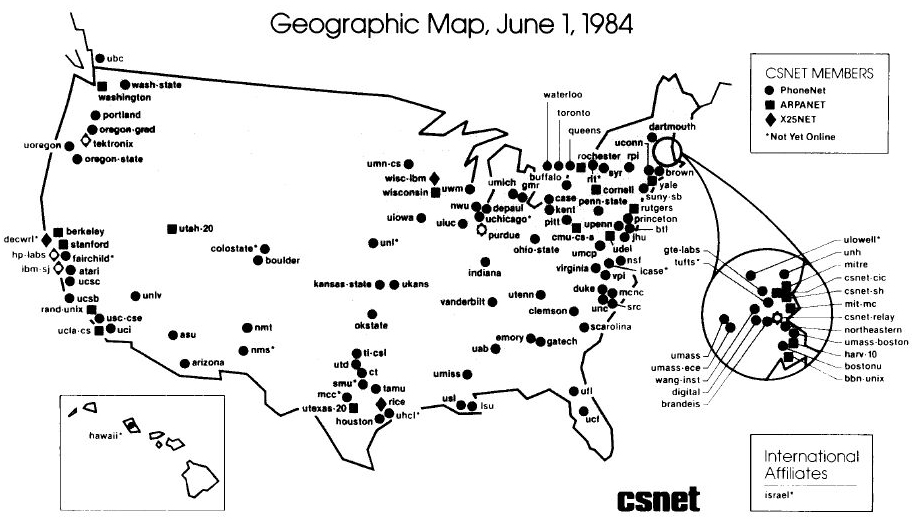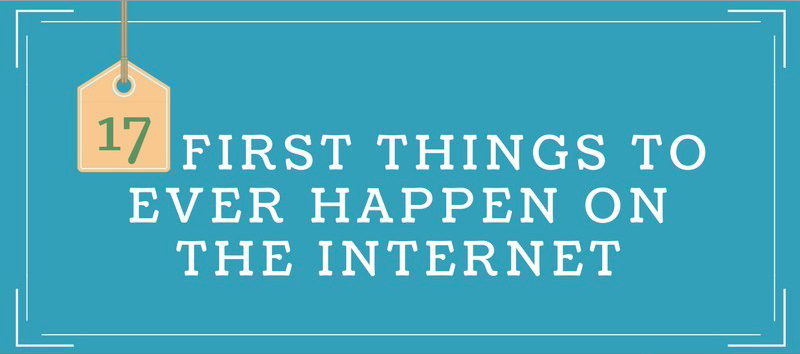ARPANET was the first internet-like network, and it was developed to allow multiple computers to share data across vast geographical distances. Interestingly, the researchers that worked on ARPANET are credited with developing many of the communication protocols that the internet still uses today. Today’s map comes from David Newbury, who shared a keepsake from his father’s time as a computer science business manager at Carnegie Mellon University in the 1970s. We added a legend to help explain the symbols on the map.
A Brief History of ARPANET
ARPANET was funded in the late 1960s by a branch of the U.S. Military called The Advanced Research Projects Agency (ARPA), with the original purpose being to allow researchers at different universities to use their limited computing resources more efficiently. Before ARPANET, if a researcher at Harvard wanted to access a database at Stanford, they had to travel there and use it in person. ARPANET was used to test out a new communication technology known as packet-switching, which broke up data into smaller “packets” and allowed various computers on the network to access the data. With ARPANET researchers could:
Login to another computer miles away Transfer and save files across the network Send emails from one person to several others
On the map above, you can see the network only had computers in the United States, but later that same year, a satellite link connected the ARPANET to Norway, creating the beginnings of a global network.
A Network of Networks
In 1983, ARPANET adopted the TCP/IP protocol standards which paved the way for a “network of networks”, and the internet was born. Several years later, ARPANET would be decommissioned and the new internet would begin to flourish. Below you can see what the early internet looked like in 1984:
A Big Jump
These maps take us back to a simpler time when social networks, mobile phones, and unlimited access to the world’s information did not yet exist. Even 12 years after the first message was transmitted on the ARPANET, there were still only 213 computers on the network. Fast forward a few decades later and the change in scale is mind-boggling – the modern internet has 1.94 billion websites and 4.1 billion internet users globally, resembling a digital universe. One can only imagine how quaint the ARPANET will look a few more decades from now. An earlier version of this article said the ARPANET was first connected internationally to the United Kingdom, but in fact, it was with Norway. on Both figures surpassed analyst expectations by a wide margin, and in January, the unemployment rate hit a 53-year low of 3.4%. With the recent release of February’s numbers, unemployment is now reported at a slightly higher 3.6%. A low unemployment rate is a classic sign of a strong economy. However, as this visualization shows, unemployment often reaches a cyclical low point right before a recession materializes.
Reasons for the Trend
In an interview regarding the January jobs data, U.S. Treasury Secretary Janet Yellen made a bold statement: While there’s nothing wrong with this assessment, the trend we’ve highlighted suggests that Yellen may need to backtrack in the near future. So why do recessions tend to begin after unemployment bottoms out?
The Economic Cycle
The economic cycle refers to the economy’s natural tendency to fluctuate between periods of growth and recession. This can be thought of similarly to the four seasons in a year. An economy expands (spring), reaches a peak (summer), begins to contract (fall), then hits a trough (winter). With this in mind, it’s reasonable to assume that a cyclical low in the unemployment rate (peak employment) is simply a sign that the economy has reached a high point.
Monetary Policy
During periods of low unemployment, employers may have a harder time finding workers. This forces them to offer higher wages, which can contribute to inflation. For context, consider the labor shortage that emerged following the COVID-19 pandemic. We can see that U.S. wage growth (represented by a three-month moving average) has climbed substantially, and has held above 6% since March 2022. The Federal Reserve, whose mandate is to ensure price stability, will take measures to prevent inflation from climbing too far. In practice, this involves raising interest rates, which makes borrowing more expensive and dampens economic activity. Companies are less likely to expand, reducing investment and cutting jobs. Consumers, on the other hand, reduce the amount of large purchases they make. Because of these reactions, some believe that aggressive rate hikes by the Fed can either cause a recession, or make them worse. This is supported by recent research, which found that since 1950, central banks have been unable to slow inflation without a recession occurring shortly after.
Politicians Clash With Economists
The Fed has raised interest rates at an unprecedented pace since March 2022 to combat high inflation. More recently, Fed Chairman Jerome Powell warned that interest rates could be raised even higher than originally expected if inflation continues above target. Senator Elizabeth Warren expressed concern that this would cost Americans their jobs, and ultimately, cause a recession. Powell remains committed to bringing down inflation, but with the recent failures of Silicon Valley Bank and Signature Bank, some analysts believe there could be a pause coming in interest rate hikes. Editor’s note: just after publication of this article, it was confirmed that U.S. interest rates were hiked by 25 basis points (bps) by the Federal Reserve.




